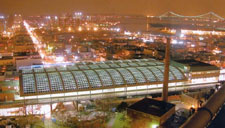...agency rescaled the project to 14 miles, basing the new $2.4-billion figure on 33% completed engineering.
Keeping close tabs on costs is key, says Neil McFarlane, TriMet capital projects executive director. TriMets contractors are brought in at the beginning of planning to catch potential construction snags. After 20 years, Portland boasts a close-knit transit-building community that shares a vision. This camaraderie helps mitigate political infighting, says McFarlane. Now, scores of other municipalities are aiming for that kind of shared transit vision.
|
More Transit Industry Participants See a Green Signal Ahead As transit managers, engineers and builders mull the future, they are finding that sustainable development is on a roll-literally. "Green" practices once reserved for buildings only are being adopted by public transit systems during construction and operation, as noted at the American Public Transportation Association's first-ever workshop on sustainability and public transportation, held July 20-22 in New York City. But conferees admitted that sustainability can put a dent in capital budgets and that practices are not always a panacea.
"This is what society and what clients are looking for, projects that are sustainable and sensitive to the community and environment," says John Lazarra, transportation planning manager of HDR Engineering, Inc., Chicago. "It's becoming a cost in doing business." The New York City Metropolitan Transportation Authority's green efforts date back to 1999 when it became the first global transit entity to conform with ISO 14001 standards. "We had a lot of pressure from EPA to do something," said Ajay Singh, chief environmental and sustainability officer at MTA Capital Construction Co. Mysore Nagaraja, MTA Capital Construction Co. president, said that as the agency gears up for a multibillion-dollar building program, it will be trying such things as fuel cell power, aluminum third rails, dust and diesel emission control, geothermal energy, humped tracks and recycled rainwater for washing transit cars. To make sustainability "a way of life," it should be introduced gradually, he pointed out. But MTA officials told conferees that a photovoltaic panel roof on a $300-million station rebuild in Brooklyn was something of a bust. Connie Crawford, MTA Capital Construction senior vice president, said the panels, expected to provide 150kW of station energy needs, did not deliver. "You're probably not going to see more photovoltaic panels going in our facilities," she added. "We will invest more in sunlight." Julie Hoover, vice president of Parsons Brinckerhoff in New York City, noted that New York City put a lot of investigation money into looking at geothermal energy for the number seven line, but after unveiling failed results decided to scrap the project. While most projects demand higher capital costs, many conferees spoke of the financial gain that sustainable transit has provided. The first LEED certified transit station, Grand Rapids Central Station in Michigan, costs just under $23 million, including the price of the land. Catherine McKalip-Thompson, sustainable development manager of Betchel Infrastructure Corporation, San Francisco, attributes the low cost to the commitment from the board and contractors to use recycled materials during construction. The station's terrazzo floor is made of recycled glass and portions of the roof are covered with live sedum. Tri-Met used recycled asphalt and concrete as base material on the Interstate MAX Yellow Line in Portland, resulting in savings of $186,000 by buying recycled materials instead of new materials. "This is an infant field," said Hoover. "It's going to cost you money and time in order to get up to speed." |



Post a comment to this article
Report Abusive Comment